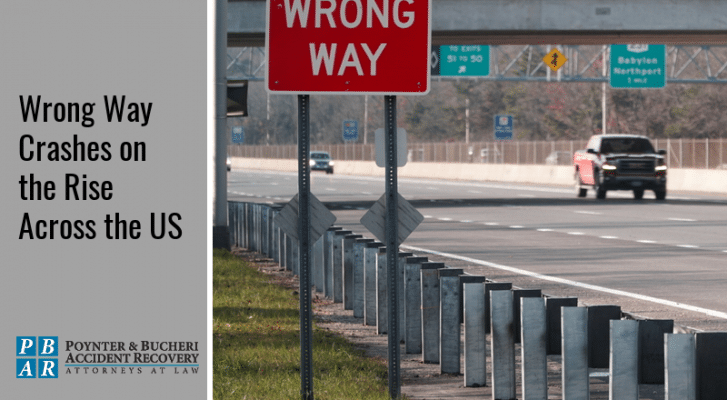
Wrong Way Crashes on the Rise Across the US

In this article, you will learn about:
- The increase in wrong way crashes in the United States
- Recent wrong-way collisions on Indiana’s freeways
- Factors in drivers driving in the wrong direction
- Countermeasures that drivers and others can take
Although wrong-way driving accounts for only 3% of accidents on high speed divided highways, these collisions are understandably the most dangerous and deadly type of crash.
For example:
- A Virginia study using data from the past few decades found that wrong way accidents were 27 times more likely to be fatal than other types of accidents.
- Another study by the California Department of Transportation found the wrong way fatality rate 12 times greater.
- A Michigan study found wrong way accidents were fatal 22% of the time, as compared to .3% of other types of accidents.
Unfortunately, although driving is getting safer as a whole, the number of wrong way crashes is on the rise across the United States. In March of 2021, the AAA Foundation of Traffic Safety and the NTSB released an unsettling report showing that the number of deaths attributed to wrong way collisions on divided highways increased by a whopping 34% when the data of 2015-2018 was compared to that of 2010-2014.
- Between 2010-2014 an average of 375 people died annually in wrong way collisions.
- Between 2015-2018 an average of 500 people died annually in wrong way collisions.
- Between 2010 and 2018 there were 44 fatal wrong way crashes in Indiana
As of 2021, this trend seems to be continuing. In Indiana alone, the past few months have seen several accidents of this type, including:
- February 3: One person died and one person was injured near Gary as a driver traveled east in the westbound lane at US 12 and Tennessee Street.
- February 7: One person died and two were injured in a head-on crash when a driver traveled north on the southbound lane of I-65.
- February 13: Three people died when a driver traveled east in the westbound lanes of I-70 near Indianapolis.
- March 7: Three people and an unborn child were killed when a woman drove east in the westbound lanes of I-265 in Floyd County.
- April 11: Multiple people were injured and five vehicles were damaged when a driver traveled east in the westbound lanes of I-70 in Indianapolis.
Why would anyone make such a fatal mistake?
There are several reasons, and each crash is different, but the AAA and NTSB found three major causes:
- Alcohol impairment: 6 out of 10 wrong way crashes involved an alcohol impaired driver ( a driver whose blood alcohol concentration (BAC) was greater than or equal to .08 g/dl (grams per deciLiter). The FARS (Fatality Analysis Reporting System) data showed that as the level of blood alcohol increased, so did the odds of being a wrong way driver.
- Older drivers: Compared to drivers aged 50 to 59, drivers in the 70- to 79-year age category and those ages 80 and over were more likely to be wrong-way drivers. The CDC reports that in general, drivers over the age of 75 have higher death crash rates than middle aged drivers, despite being less likely to drink and drive. They suggested several reasons for aged drivers to crash: deteriorating vision, possible cognitive decline, and other physical changes.
- Driving without a passenger: That factor makes sense when you think about it. Without a passenger to shout, “You’re going the wrong way!” a confused or impaired driver is without a lifeline. Fully 87% of wrong-way drivers are traveling alone.
Countermeasures
The AAA/NTSB report concluded by suggesting certain countermeasures designed to decrease the number of wrong-way driving on divided highways or to lessen the damage once someone found themselves in such a situation:
- Alcohol ignition interlocks
- More obvious signs saying “Wrong Way,” “Do Not Enter,” and “One Way.”
- Raising medians to discourage left turns onto exit ramps
- Red retroreflective pavement markings on ramps
- LED illuminated signs
- Red rectangular flashing beacons
- Portable tire deflation devices for those entering on an exit ramp
- Flashing signs that would warn other drivers of a wrong way driver
Drivers should NOT
- Drink and drive, and do not drive under the influence of any substance
- Drive if they feel fatigued. Confusion and delayed reaction time can result from driving while tired.
If you have been injured in a head on collision as a result of a driver traveling in the wrong direction, consult the car accident attorneys at Poynter & Bucheri Call 1-800-265-9881 or (317) 780-8000 now to speak with a PBAR representative. You can also chat with a representative 24/7 on our website to get the help you need now!
